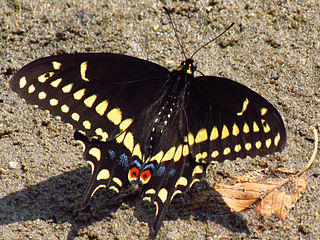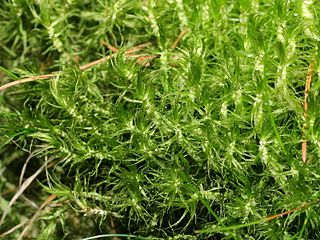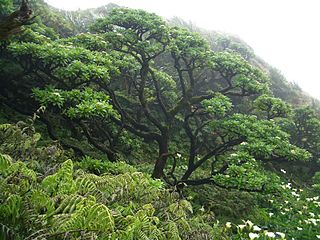
Papilio polyxenes, the (eastern) black swallowtail, American swallowtail or parsnip swallowtail, is a butterfly found throughout much of North America. It is the state butterfly of Oklahoma, Michigan, and New Jersey. An extremely similar-appearing species, Papilio joanae, occurs in the Ozark Mountains region, but it appears to be closely related to Papilio machaon, rather than P. polyxenes. The species is named after the figure in Greek mythology, Polyxena, who was the youngest daughter of King Priam of Troy. Its caterpillar is called the parsley worm because the caterpillar feeds on parsley.

Dicranum is a genus of mosses, also called wind-blown mosses or fork mosses. These mosses form in densely packed clumps. Stems may fork, but do not branch. In general, upright stems will be single but packed together. Dicranum is distributed globally. In North America these are commonly found in Jack pine or Red pine stands.

The flora of Saint Helena, an isolated island in the South Atlantic Ocean, is exceptional in its high level of endemism and the severe threats facing the survival of the flora. In phytogeography, it is in the phytochorion St. Helena and Ascension Region of the African Subkingdom, in the Paleotropical Kingdom.

Hymenophyllum is a genus of ferns in the family Hymenophyllaceae. Its name means "membranous leaf", referring to the very thin translucent tissue of the fronds, which gives rise to the common name filmy fern for this and other thin-leaved ferns. The leaves are generally only one cell thick and lack stomata, making them vulnerable to desiccation. Consequently, they are found only in very humid areas, such as in moist forests and among sheltered rocks. They are small and easy to overlook.
Ablation Valley, also known as Ablation Bay, is a mainly ice-free valley on the east coast of Alexander Island, 3 km (1.9 mi) long, which is entered immediately south of Ablation Point, opens on George VI Sound and lies immediately north of Ganymede Heights. It was first photographed from the air on 23 November 1935 by Lincoln Ellsworth and mapped from these photographs by W.L.G. Joerg. It was first visited and surveyed in 1936 by the British Graham Land Expedition (BGLE), and given the name "Ablation" by them because of the relatively small amounts of snow and ice found there. The site lies within Antarctic Specially Protected Area (ASPA) No.147.

Celery mosaic virus (CeMV) is a plant pathogenic virus in the genus Potyvirus and the virus family Potyviridae .
Troglophyton is a genus of flowering plants in the family Asteraceae, native to southern Africa.

Parnassia caroliniana is a species of flowering plant in the Celastraceae known by the common name Carolina grass of Parnassus. It is native to the southeastern United States, where it occurs in North Carolina and South Carolina, with an isolated population in the Florida Panhandle.

Ditrichum is a genus of haplolepideous mosses (Dicranidae) in the family Ditrichaceae.

Distichium is a genus of haplolepideous mosses (Dicranidae) in the monotypic family Distichiaceae.
Anastrophyllum is a genus of liverworts belonging to the family Anastrophyllaceae.
Dichelyma is a genus of mosses belonging to the family Fontinalaceae.
Heterocladium is a genus of mosses belonging to the family Thuidiaceae.
Marathrum is a genus of flowering plants belonging to the family Podostemaceae.
Nanobubon is a genus of flowering plants belonging to the family Apiaceae.








